Batteries for solar panels: overview of types of suitable batteries and their features
Alternative energy systems are increasingly used to supply residential buildings with electricity.Since the modes of generation and consumption of electricity differ, it is necessary to ensure its accumulation for subsequent output. Do you agree?
In order to use energy for the period of time required by the owner, batteries for solar panels are included in the scheme. We will tell you how to correctly select devices designed to operate in charging and discharging cycles. Our recommendations will help you choose the optimal model.
The content of the article:
Batteries in a household solar energy system
Understanding the methods and nuances of using batteries when providing a facility with electricity from solar panels will allow you to make the right choice of devices and ensure maximum system efficiency.
To make an informed purchase, you need to thoroughly understand the methods of creating a battery array (block) and the rules for calculating the main characteristics.
Method of combining devices into a single array
Residential and industrial applications consume electrical loads that exceed the capacity of a single battery. If the solar energy system is designed for a large number of electrical appliances, it is necessary to create an array of rechargeable batteries following the example of such a combination solar panels.
Connecting batteries to a single electrical storage array can be done in parallel, serial or mixed ways. The choice depends on the required output power and voltage.
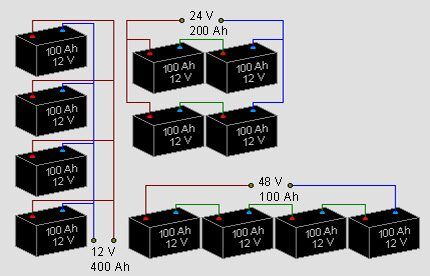
Batteries are placed in a house or other building to ensure that the ambient temperature is in the range of 10 to 25 degrees Celsius above zero and to prevent water from entering them. This significantly extends the service life of devices and reduces energy losses.
Modern technologies for the production of rechargeable batteries intended for placement in residential buildings provide for increased environmental safety measures. Therefore, there is no need to take any special measures for intensive ventilation of the room. However, they should not be placed in living rooms.
Since batteries have significant weight (a 12 Volt and 200 Ah device weighs about 70 kg), they must be placed on the floor or on strong and securely fastened racks.
It is necessary to prevent the possibility of batteries falling from a height, since in this case they will fail, and systems with liquid electrolyte are also dangerous to human health if they become depressurized.
As the length of the power cable increases, the electrical resistance increases, which leads to a decrease in system efficiency. Therefore, it is practiced to place batteries close to each other in order to minimize the total length of wires.
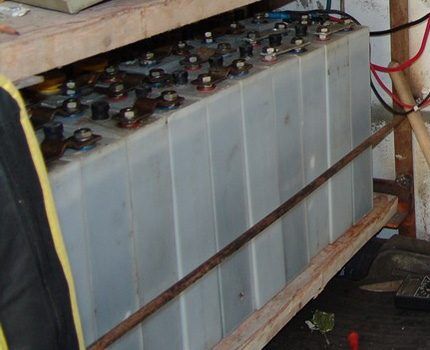
Features of the system functioning
With parallel and combined series-parallel connection of batteries into a single array, devices may become unbalanced in terms of charge level. This leads to the fact that the device will not function in full cycle, which means that its resource will be exhausted faster.
The system for generating electricity from the sun is always equipped controller, which controls the battery charge. In the case of creating an array of batteries, it is additionally necessary to install charge equalizing jumpers.
To avoid problems of uneven charging and discharging of batteries combined into a single array, it is necessary to use devices of the same model, or, even better, from the same batch. This rule is relevant not only for solar energy systems.
Now almost all housing can be provided with appliances operating on a 12 or 24 Volt network, including refrigerators, televisions, etc. However, wiring with such voltage throughout the house does not make sense, since the current power will be very high.
This means that when implementing such an idea, an expensive cable with a large cross-section of cores is required and losses from electrical resistance will be high.

Therefore, in the immediate vicinity of batteries they install inverter – a device for converting electrical voltage.
In addition, the actual output voltage from the battery pack may differ slightly from the stated voltage. So, fully charged ones are popular for use in scheme with solar panels gel batteries produce a voltage of 13-13.5 Volts, so the inverter functions as a stabilizer.
Calculation of required battery capacity
The capacity of the batteries is calculated based on the expected period of autonomous operation without recharging and the total power consumption of electrical appliances.
The average power of an electrical appliance over a time interval can be calculated as follows:
P = P1 *(T1 /T2),
Where:
- P1 – rated power of the device;
- T1 – operating time of the device;
- T2 – total estimated time.
Almost throughout the entire territory of Russia there are long periods when solar panels will not work due to bad weather.
It is not cost-effective to install large arrays of batteries to fully charge them only a few times a year. Therefore, the choice of the time interval during which the devices will operate only on discharge must be approached based on the average statistical value.
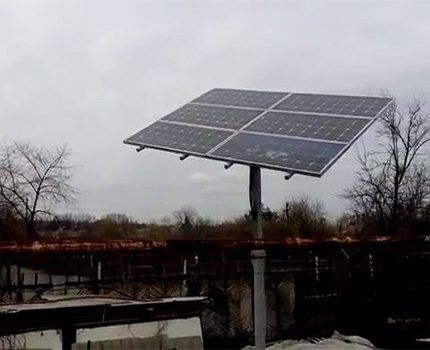
If you plan to use the accumulated energy during the day, for example, in solar heating, then it is better to take into account a slightly larger interval, such as 30 hours.
In case of a long period when it is not possible to use solar panels, it is necessary to use another system for generating electricity, based, for example, on a diesel or gas generator.
A 100% charged battery can produce power before it is completely discharged, which can be calculated using the formula:
P = U x I
Where:
- U – voltage;
- I – current strength.
So, one battery with a voltage of 12 volts and a current of 200 amperes can generate 2400 watts (2.4 kW). To calculate the total power of several batteries, you need to add up the values obtained for each of them.
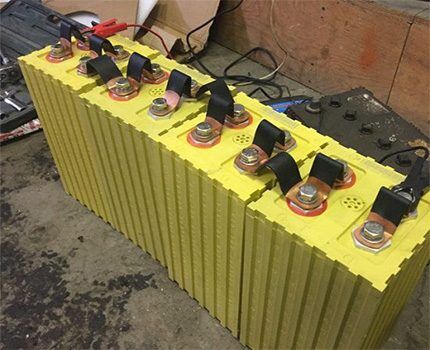
The result obtained must be multiplied by several reducing factors:
- Inverter efficiency. With proper matching of voltage and power at the input to the inverter, a maximum value of 0.92 to 0.96 will be achieved.
- Efficiency of power cables. Minimizing the length of the wires connecting the batteries and the distance to the inverter is necessary to reduce electrical resistance. In practice, the value of the indicator is from 0.98 to 0.99.
- Minimum permissible battery discharge. For any battery there is a lower charging limit, beyond which the service life of the device is significantly reduced. Typically, controllers set the minimum charge value to 15%, so the coefficient is about 0.85.
- Maximum permissible loss of capacity before changing batteries. Over time, devices age and their internal resistance increases, which leads to an irreversible decrease in their capacity. It is unprofitable to use devices whose residual capacity is less than 70%, so the value of the indicator should be taken as 0.7.
Contrary to popular belief, battery efficiency - the ratio of received and supplied electricity - should not be included in the calculation. The battery capacity indicated in the technical documentation takes into account the possible return volume.
As a result, the value of the integral coefficient when calculating the required capacity for new batteries will be approximately 0.8, and for old ones, before they are written off, it will be 0.55.
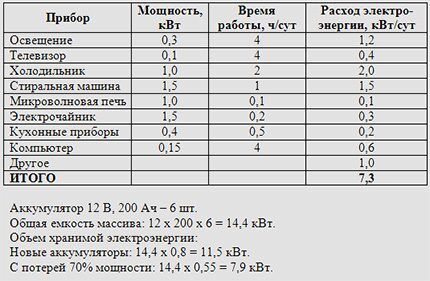
Maximum permissible currents
For each battery, the technical documentation specifies the maximum permissible charge current. Exceeding this value leads to overheating of the device, a sharp and irreversible decrease in its performance.
Therefore, when choosing batteries for battery system assembly you need to make sure that they can handle the electricity generated by the solar panels.
Another important indicator is the permissible discharge current:
- Standard discharge current, the value of which (or a smaller value) the battery is designed to operate at. The operation of all electrical equipment connected to the system must be ensured by this indicator.
- The maximum discharge current that the device can provide for a short time under peak loads. Such loads can occur when some equipment is turned on, for example those containing refrigerator or air conditioning compressors.
Exceeding the first indicator for a long time or the second for a short time leads to premature wear of the battery. As devices age, these figures decrease by 20-30%, which also needs to be taken into account.
Device features and main parameters
Car batteries are not designed to handle many charge and discharge cycles. For alternative and reserve energy, devices of a different type are used. Since their cost is high, it is necessary to carefully study all the parameters before purchasing.
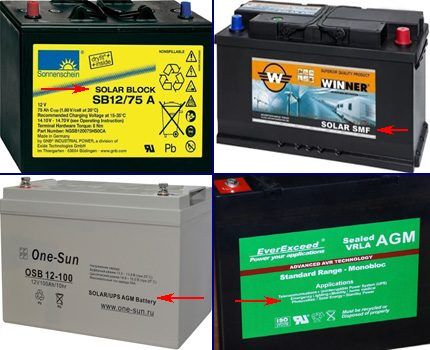
Types used for alternative energy
Almost all batteries used in alternative energy and installed in buildings are of the maintenance-free type. The user is not able to perform physical operations with them that affect their structure.
This is done to minimize the risk of physical or chemical exposure of batteries to people, the air and their surroundings. Therefore, there is no need for a detailed study of the structure and physical and chemical nuances of the operation of different types of batteries. More attention should be paid to the differences in the basic technical characteristics of the devices.
OPzS batteries are designed like simple lead-acid devices. The change in the shape of the positive plate allows for a significantly higher number of charge and discharge cycles than automotive equivalents.
The disadvantage is the presence of liquid electrolyte, which can be dangerous if they depressurize. Average price niche.
Alkaline (nickel) batteries are rarely used due to their insensitivity to low currents when charging and the need to go through a full cycle from charged to discharged state. Otherwise, the battery capacity will decrease.
Also, these devices have greater weight and dimensions compared to competitors of the same capacity. Dangerous if depressurized. Low price niche.

In AGM batteries, the electrolyte is bound in a fiberglass structure. They can be charged with low currents.They are practically safe and occupy an average price niche among competitors.
In GE (gel) batteries, silicon oxide is added to the electrolyte, resulting in a gel-like state. The devices have a high degree of safety and good performance. High price niche.
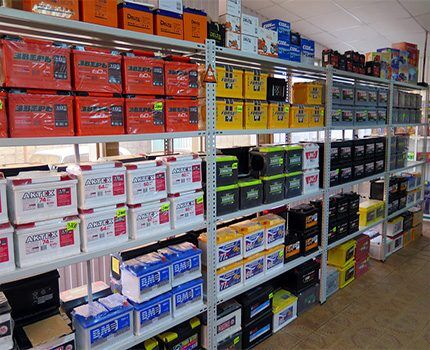
Lithium-based batteries (for example, lithium iron phosphate models) have very good performance, are compact, have significantly less weight, and are practically safe. However, their cost is significantly higher than that of competing types of devices, even gel ones.
From the point of view of the ratio of price and technical characteristics, gel and lithium batteries are the most attractive. But the one-time initial investment in them is quite large, so other types of devices are also widespread in the battery market for alternative energy.
The following brands of batteries are in active demand in the domestic market:
The presented batteries are characterized by excellent performance characteristics and an affordable price.
Selecting a battery model
The main parameters of solar energy batteries that you need to pay attention to when purchasing are the following:
- voltage and capacity that determine the battery power;
- depth of safe maximum discharge, subject to which the battery can operate within the time limits stated by the manufacturer;
- guaranteed number of charge and discharge cycles subject to all technical conditions;
- self-discharge value, characterizing the intensity of electricity loss in a charged battery during idle time;
- maximum charge current, which determines the amount of electricity per unit of time that the battery can accept without compromising further operation;
- standard discharge current, which determines the amount of electricity per unit of time that the battery is capable of delivering for a long time without compromising further operation;
- maximum discharge current, which determines the amount of electricity per unit of time that the battery is capable of delivering for a short time without compromising further operation;
- optimal temperature for device operation;
- size and weight of the battery, knowledge of which is necessary to select their location and installation method.
All these parameters are described in technical documentation, which is posted electronically on the website of all major manufacturers.
Conclusions and useful video on the topic
Review of the nuances of functioning of different types of batteries for solar systems:
Comparisons of different types of starter batteries. Pros and cons for alternative energy:
Experience in using lithium (LiFePo4) batteries. A real block of automotive devices, the nuances of its operation:
The correct choice of batteries according to their parameters will ensure reliable operation of the alternative energy system.There is no need to save excessively on an electricity storage unit - the initial start-up investment will be recouped by the uninterrupted operation of the system for several years to come.
Please leave comments in the block below, ask questions, post photos on the topic of the article. Tell us about how you chose batteries for your country mini-power station from solar panels. Share information that will be useful to site visitors.




Solar energy is still an expensive business. At least the average household will not be able to afford the purchase of photovoltaic cells and batteries. Moreover, you will also have to purchase and install additional monitoring devices. But technology does not stand still, and I think in 10 years the price of lithium batteries will become lower or they will come up with another, cheaper way to store energy.
Using my own example, I can say that the operation of solar panels throughout almost the entire territory of Russia is complicated by climatic conditions. Yes, such a battery will be quite sufficient to illuminate the lawn in the summer. But for the average person, in my opinion, it is not yet possible to count on anything more serious, especially in winter. Too often the sky is cloudy. If Russia ever comes to its senses and begins to massively develop options for using “green” energy sources, then the formula for calculating battery capacity given in the material above will become relevant. This is just IMHO, and maybe someone is already living entirely off the energy of the Sun. And this someone laughs at those who count pennies to pay electricity bills (or at those who collect dead wood.
I, like many others, was interested in this direction. They are discussing solar energy, but what can you say about wind? I understand that it is just as unstable as solar energy in Russia, especially in the northern regions. But as for me, in the Northern (Len. region) winds prevail. and perhaps if we put 2 types (solar and wind generation), then we can close the issue with generation, but the issue of storing electricity remains open.